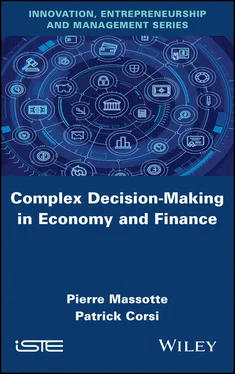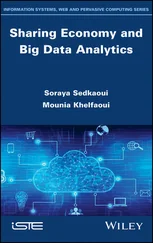1 Cover
2 Introduction: New Beginnings Introduction: New Beginnings I.1. A present-day situation The world is constantly changing. Disruptions have come of age. Their rhythms and frequencies are accelerating , and the perception of the world in which we live continues to evolve towards ever greater sophistication and complexity. Surprisingly, while complexity is found everywhere and remains intrinsic to Nature, various works have led to a curious discovery: that a reduction in the level of complexity is not an advantage in terms of diversity – which leads to the creation of solutions and of co-evolution [BOU 03], for instance for the development of new business processes and information systems. Complexity is part of the times. Due to nonlinearities and feedback loops, it provides robustness and at the same time adaptability to systems. On the contrary, when too low, it leads to problems in terms of conduct or stability of results. Those can even be “deadly” and hinder the very evolution of Nature’s systems. The science of complexity is only in its infancy, and we understand scientifically only a tiny part of it. It would therefore be pretentious to want to explain its theory and foundations. Yet, this science has allowed new concepts to emerge. We were confronted with this reality at IBM Europe every time its Advanced Technologies Group – the ATG Competency Center had to deal with issues related to the management and control of complex systems. In the absence of theoretical foundations, it was from experimentation and pragmatism that we built our own “philosophy” on complexity. Furthermore, the Ecole de Mines d’Alès in Southern France enabled us to better develop and control certain aspects of complexity and to consolidate these industrial experiences. This book discusses some principles and methodologies designed to better understand and control, or even manipulate, these new concepts. The transition from “simple” to “complex” applies to most natural phenomena because they are governed by the same fundamental laws, from the infinitely small to the infinitely large – the cosmos – and whatever the domains of activity we consider; here lies a principle of universality. The results are already far-reaching, and the approaches we have developed, by also using multidisciplinary concepts , can be implemented in most of the complex processes or systems we encounter in the socio-economic world. Today, the contribution of information technologies makes it possible to finally provide efficient solutions to problems that were sometimes known for a long time.
I.1. A present-day situation I.2. A basic awareness: the governance of a system I.3. What lies ahead of us? I.4. Guidelines and ways forward
3 PART 1: Dealing with Complexity 1 Engineering Complexity within Present-Day Industrial Systems1.1. Introduction 1.2. Basic properties of complex industrial systems 1.3. The complexity of systems 1.4. Analysis of some industrial dynamic systems 1.5. Applications of new concepts in industrial systems 2 Designing Complex Products and Services2.1. Complex systems engineering: the basics 2.2. The implementation conditions for self-organization 2.3. Advantages and benefits of a complexity approach 3 Engineering and Complexity Theory: A Field Design Approach 3.1. Design approach for a complex system 3.2. Applications and solutions 3.3. Application: organization and management in companies 3.4. Main conclusions related to the first three chapters 4 Organizational Constraints and Complexity Theory: Modeling with Agents 4.1. A preamble to modeling 4.2. Introducing collective intelligence 4.3. Studying the agent concept 4.4. Applications using agents 4.5. Conclusion: information related to the use and usage of modeling 5 Complexity and the Theory of Organizations: Implementation of Collective Intelligence 5.1. Introducing the notion of collective intelligence 5.2. Definition of a multi-agent system 5.3. Behavioral and interaction strategies between agents 5.4. Concluding comments 6 Complexity and the Theory of Organizations: The Notion of Collective Patterns 6.1. The emergence of collective patterns 6.2. System complexity factors and their measurement 6.3. Conclusion: towards the notion of “complex adaptive systems” (CAS) 7 Complexity and Theory of Organizations: Structure and Architecture of an Enterprise 7.1. Notions of structure in organizations 7.2. Structure of distributed complex systems 7.3. Conclusion 8 Complexity and the Theory of Organizations: Applications 8.1. Applications: trends and models 8.2. Application and implementation of concepts in the “Fractal Factory” 9 Complexity and the Theory of Organizations: Complex Systems Reengineering 9.1. The reengineering of complex systems 9.2. Comments on the technologies used 9.3. Theory of constraints and complexity management 9.4. Measurement of the complexity of a new organization 9.5. Concluding remark 10 Evaluating and Measuring Complexity: The CINSYS Methodology 10.1. A brief overview of the CINSYS system 10.2. What can be found in a CINSYS model? 10.3. Functional analysis of the method: interpretation by the CINSYS symbolic and structural diagram 10.4. Illustration of the method 10.5. What are the advantages of using the method? 10.6. “The network metaphor” as the general application context of the method 10.7. Perspectives beyond the CINSYS method 10.8. Conclusion
4 PART 2: Dealing with Risk in Complex Environments 11 Underlying Mechanisms in Finance11.1. Introduction to finance theory and its evolution 11.2. What are the best candidates for the so-called econophysics? 11.3. Action plans in financial regulation and bank regulation: are they ok? 11.4. Back to physics and matter: their contribution 11.5. From matter up to living beings: how can big events be generated? 11.6. The evolution of an economic system – the problem of CRISIS 11.7. Role of complexity and diversity in Nature 11.8. Application: how should we proceed when faced with crises and financial crashes/crises? 11.9. Crisis as the end of an evolution 11.10. Collapse theory and modeling – a theory of the “end” 11.11. Design of financial products: the example of world interconnections 11.12. Conclusion 12 Physics and Social Networks: Domain Similarities12.1. Introducing a similarity of domains 12.2. On the principle of emergence 12.3. Finance, economics and physics: the quantification of emergence 12.4. About Gödel theorems 12.5. Conclusion 13 Managing Behavioral Risks: Uncertainty and Catastrophes 13.1. Introduction 13.2. Implications for intellectual approaches 13.3. The uncertainties 14 On Managing Risk in the Energy Domain: Conventional Problems Encountered 14.1. From a new oil crisis (peak oil) and the resulting energy crisis 14.2. The future: limit of price increases? Implications of the shortage 14.3. Modeling the problem correctly 14.4. Crisis or heuristic tactics? Large-scale oil shock? 14.5. A few conclusive remarks 15 On Managing Risk in the Financial Domain 15.1. Taking about disasters – from risks to catastrophes in finance 15.2. An interesting approach: financial analysis of losses 15.3. When the drama occurs 15.4. How to conduct a risk consequence analysis process? 15.5. Conservatory measures: risk and diversification 15.6. An additional risk: the decline and inversion rate at the stock exchange 15.7. Concluding with additional risks of the shared economy 16 Why Current Tools Are Inadequate 16.1. On the shortcomings of current tools: risk and probability 16.2. A thematic illustration 16.3. What regularities? 16.4. Characteristics of rational expectations in economics 16.5. Risk characteristics in the industry 16.6. A philosophical summary: chance and necessity 16.7. The environment’s new challenge 17 How to Manage Crises? 17.1. The fundamental principles of crisis management 17.2. Early warning risk signals and the basics of risk management 17.3. Five fundamental elements that describe a company 17.4. About stakeholders 18 Managing Crises in Finance and Other Domains 18.1. Reorienting company aims 18.2. Interactions: towards a crisis model? 19 Technological, Monetary and Financial Crashes19.1. Yet another view to complexity 19.2. The reference financial systems are continuously changing 19.3. Conclusive discussion
Читать дальше












